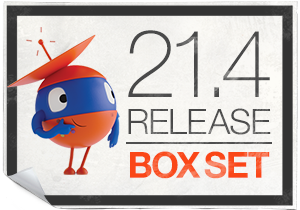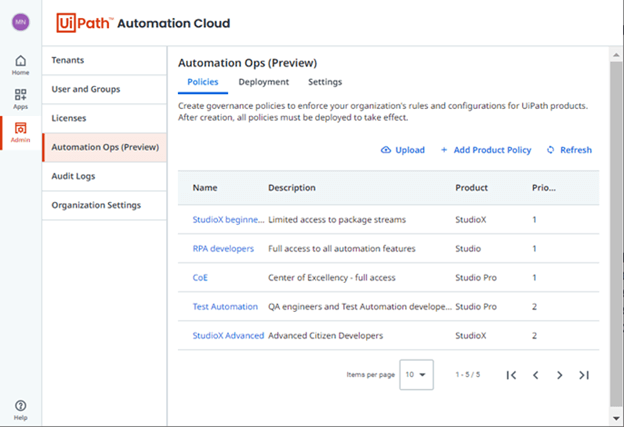Enterprise-Scale Management and Governance of Your Automation Program


Automation has come a long way from the first enterprise implementations. For early automation adopters, scaling automation projects required finding (or sometimes building!) the right tools to tackle new challenges that came with scaling, such as:
How do you discover the most important processes to be automated?
How do you get more people involved in, and benefiting from automation?
How do you deploy and manage robots and automations at enterprise scale?
And most of all: how do you do all this without compromising security or quality?
The questions have not changed, but the answers certainly have!
Throughout the years, we’ve worked alongside our customers to expand UiPath Platform capabilities to address those different areas with ever-more turnkey features. So, you can build and manage the fully automated enterprise™ more easily with governance at the core of your automation architecture.
Comprehensive planning for automation at scale
Planning for automation at scale with UiPath now fully addresses the multiple angles the opening questions imply. And those questions are addressed with a structured, manageable approach to:
Scaling automation use
What seemed to be a very distant goal of ‘a robot for every person™’ a few years ago has now turned into something tangible with UiPath Assistant, Chatbots, and UiPath Apps by making it easy for people to engage with robots more deeply. And more people inside enterprises are now actively engaging with and benefiting from robots every single day.
Increasingly powerful services mean the sky is also the limit for the ways unattended automation can take care of ever more complex automations, quickly alerting people through UiPath Action Center if robots have questions or need validation.
Increasing the size, quality, and management of your automation pipeline
You can do this through crowdsourcing with UiPath Automation Hub or capturing and mining tasks and processes with other discovery-related products. We’ve written an entire blog post about this very topic—check it out.
Finding the most efficient ways to address your automation pipeline
Some organizations find citizen development to be the most efficient way to address their automation pipelines. Others focus on artificial intelligence (AI) and machine learning (ML) innovation or prioritizing professional RPA development resources based on ROI.
More people inside a company can contribute to the development of automation projects than ever before. Innovations like low-code citizen development, long-running-workflows, AI/ML integration, test automation, and Apps can bring multiple automations together easily. More contribution options help you further scale automation development.
Governance for a new type of user
Scaling automation development brings up more questions:
How do you enforce development standards across the organization, especially if citizen developers may not necessarily have the same understanding of risk that a professional developer does?
How do you think through security implications and implement policy in your automation environment when automations are being developed at scale?
How do you simplify collaboration and maximize the development benefit? Across departments, across teams, and why not across continents? How do you take an automation built in your French finance department and validate it for your New Zealand team as well?
Introducing UiPath Automation Ops
In this 21.4 release, we’re expanding the existing strong governance capabilities in UiPath Orchestrator with a new set of scale governance capabilities called Automation Ops. Automation Ops addresses the specific challenges of automation governance at scale and adds new capabilities to manage UiPath Assistant for attended automation.
Automation Ops is a cloud-first, web-based application that enables organizations to quickly setup automation policies and package sources. With Automation Ops, you can govern large deployments of the UiPath Studio family of products (where automatons are built) as well as UiPath Assistant (where attended automations are run). Easy deployment from Automation Cloud™ means that controls can be applied immediately to an existing install base. It was built in parallel with Studio and UiPath Assistant to offer oversight and control without intrusion or undue restriction on the developer’s experience. Which means most of the time your developers won’t notice the difference, but your organization will.
Automation Ops is deployed at the organization level and allows centralized control. But it can also be tailored to individual needs or to support groups of people who have different levels of automation skills or access.

A four-pronged approach to controlling your development cycle
Automation Ops, together with the many governance features in UiPath Orchestrator, means you can implement a four-pronged approach to standards and security. The approach helps you ensure everyone maintains a safe environment as projects are built and deployed.
First, before any development begins:
Discover which processes to automate
Decide which automation should be done by citizen developers and which require the input of a robotic process automation (RPA) developer
This very important prequel work can be taken care of in Automation Hub, building the foundation for your development cycle
Once development starts, the next step is controlling the inputs of automation projects. That includes having safety checks in place that limit access for inexperienced developers and give more experienced developers a broader range of development choices such as:
Custom policy configuration for your organization
Policy deployment down to user level
Policy deployment includes the ability to restrict the applications and URLs that can be automated. It also allows you to control the feeds, packages, and activities that can be used.
The third step is to control the outputs and deployment of automations:
Use built-in rules to ensure compliant high-quality automations.
Enforce analyzer checks on developers before running or publishing an automation. These policy-driven checks make sure that the work fits with company rules for naming and deployment, as well as enforcing automation quality standards set by the center of excellence (CoE).
Controlling (via Automation Ops policy) the widgets that are made available in UiPath Assistant for specific groups of users.
Controlling automations versioning and deployment.
For example:
Using personal workspaces so a citizen developer can run their own automation – but nobody else can.
If that same automation is reviewed and approved for broader distribution, managing that deployment.
Leveraging new Azure AD integration to manage distribution of automations to users based on Azure AD group membership.
The fourth and final step is ensuring logging and auditing of everything that your robots do, as well as the results, through Orchestrator:
All robot action logs are centralized in Cloud Orchestrator, which can now be exported to Amazon Web Services (AWS), Azure, or Google Cloud storage for long-term retention.
Insights—also newly available in Automation Cloud with this release—enables you to analyze longer-term trends on everything from Robots to ROI from within the portal.
We’re excited to bring you Automation Ops in this release, extending the management and governance baked into the UiPath Platform. We encourage you to give it a try today (along with the new capabilities in Orchestrator) by logging in to your Cloud Account and creating your first rules.
We have even more plans for our entire governance strategy over the coming months, including further Automation Ops capabilities. Feedback has been central to our ability to help our customers successfully scale automation benefits in their organizations. We look forward to hearing more about what your governance needs are, now and in the future!
Want to learn more about the updates included in the 21.4 release? We've created an entire 21.4 'boxed set' of resources for you to explore at your convenience.

Director, Product Marketing, UiPath
Get articles from automation experts in your inbox
SubscribeGet articles from automation experts in your inbox
Sign up today and we'll email you the newest articles every week.
Thank you for subscribing!
Thank you for subscribing! Each week, we'll send the best automation blog posts straight to your inbox.



